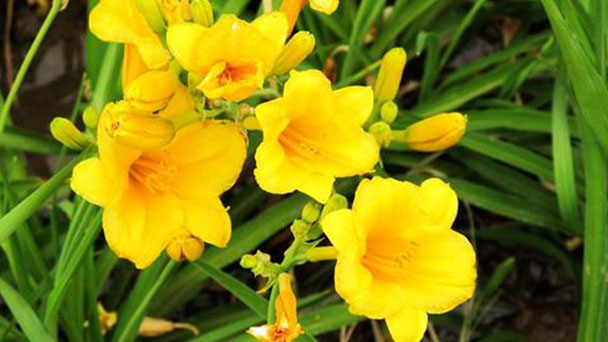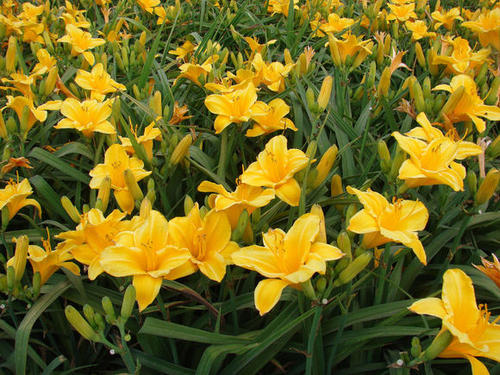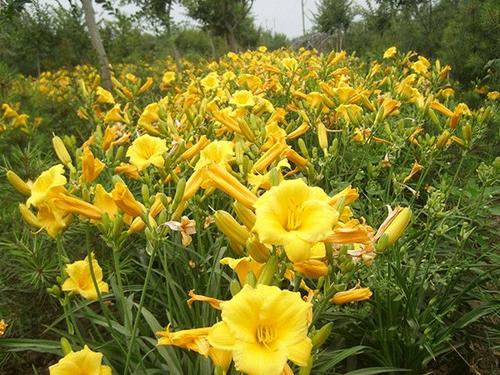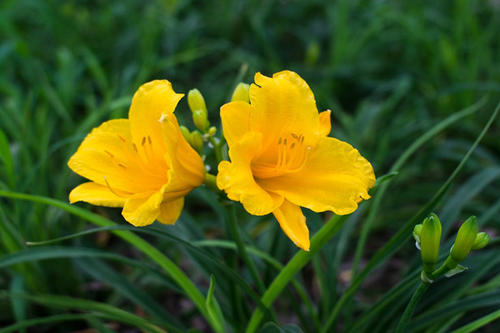Daylily info: how to grow and care for day lily
Written by Maggie
Sep 11 2021

Daylily (Hemerocallis), also called day lily, is a cultivated horticultural variety of day lilies. Plant height is 30 cm, flower grass stout, about 35 cm high. Inflorescences are spirally cymes with 7 to 10 flowers.Corolla is funnel-shaped, 7-8 cm in diameter, golden yellow.
Daylily picture

Morphological characteristics of daylily
The root
The whole plant of Daylily is smooth and glabrous, and the plant height is 30 cm. Rhizome is short, with fleshy fibrous roots, roots sub fleshy, underground with rhizomes and fleshy hypertrophic fusiform root tubers.
Leaf
Daylily leaves are generally wide, with roots clustered, narrow and long into linear veins, with obvious main veins and mutually wrapped at the base. Leaves are basal, striped, arranged in two rows, ca. 25 cm long and 1 cm wide.
Flowers
Daylily scapes extracted from leaf clusters, upper branches, round inflorescences, a number of peanuts on the top, big yellow flowers. Apex is 6-lobed campanulate, lower part tubular. Perianth tubes are shorter and thicker, 2-3 cm long; Inner perianth lobes are 2-3 cm wide.
DayLily flower sprout stout, about 35 cm high.Inflorescences spirally cymes with 7 to 10 flowers. Corolla is funnel-shaped, 7-8 cm in diameter, golden yellow.
Daylily flowers bloom in the morning and fade in the evening, without fragrance, orange to orange, and generally have ∧ shaped picking spots in the lower part of inner perianth lobes. These characteristics can be distinguished from other domestic varieties.
The flowering period of Daylily is from spring to autumn and the single flower blooms for 5 to 7 days.
The ecological habits of daylily
Daylily is light-loving and resistant to drought, moisture and semi-shade. Daylily has strong adaptability to soil, but it is better to choose fertile sandy loam with deep soil, rich humus and good drainage. Less pests and diseases, in the neutral, alkaline soil can grow well.Cold resistance, underground rhizome can withstand the low temperature of -20 ℃.
When to grow daylily
Container-grown or bare root daylilies can be planted in spring or no later than 6 weeks before the first frost in autumn. In mild climates, they can be planted in summer. They’ll take about a year to establish themselves and then will spread quickly, forming dense clumps.
Where to grow daylily
For best blooming, plant in an area that will receive at least 6 hours of sun. They will tolerate poor soil quality, but not poor drainage, so make sure the site drains well. Daylilies are one of few plants that can be planted under black walnut trees because they are not affected by the chemical juglone that is leached into the soil by the tree.
How to care for daylily
Soil
DayLily likes warmth and sufficient sunshine, and is hardy to cold. The requirement of deep and fertile soil, potted soil loose, well drained. Fertilizer regularly during the growing season. In the north, underground tubers should be dug up before frost and stored in an environment with a temperature of about 5 ℃. Because of its large flowers, colorful, colorful, good plant shape, easy cultivation. The optimum temperature for open cultivation is 13-17℃. The soil requirements are not strict, in loose, fertile, well drained sandy loam growth best, also adapt to the growth of fertile clay soil.Jiangnan can overwinter in the windbreak.
Planting distance
Daylily is a dwarf variety and is a perennial root flower with high reproduction coefficient. The ornamental effect is not good if it is planted sparsely, and the close planting will affect the ventilation and dividing growth. The general plant row spacing is 20×20 cm or 15×25 cm is appropriate. One or two points planted once. Cultivation soil should be moist, fertile and well-drained sandy loam. After planting, spray high fat film, which can effectively prevent moisture from evaporating on the ground and transpiration of the seedling body, isolate diseases and insect pests, and shorten the slow seedling period.
Water
DayLily has a long flowering period, and the spray of flowers can make the flower bud strong, the petal hypertrophy, the color is gorgeous and the flowering period is prolonged. Green period is also long, in the fertilizer and water management requirements to apply sufficient base fertilizer, after the flowering period to organic fertilizer and compound fertilizer. During the period of cultivation, the soil was loosened and weeded once or twice in spring and summer. March to 6 months, every month 3 times -5 times the water of decaying human excrement fluid, such as 1 time before the flower phosphate fertilizer, can improve the quality of flowers. Daylily like wet, timely watering, spraying new high fat film to protect fertilizer and soil moisture.
Winter care
In northern areas, newly planted daylilies can be mulched in late fall. This is important for young plants which otherwise may be heaved out of the ground the first winter. Dead foliage can be removed in spring, unless it was diseased. In that case it is best to remove it in fall.

The propagation of daylily
Daylily can be propagated by tissue culture and plant division.
Daylily annual propagation coefficient is generally 1∶6, fertile soil can reach 1∶10. Planting can be carried out during dormant period.
DayLily in spring will be more than two years old plants dug up, a bud into a plant, each plant must have a complete bud head, and then according to the row spacing of 40 cm, 25 cm, planting hole depth of 10~12 cm, the first base fertilizer into the pit, slightly covered with fine soil, and then planted, after planting soil 4 cm -5 cm, compaction, and then pouring permeability.
Daylily planting can also be done in March.Jiangsu and Zhejiang before the beginning of February, the dense plant clusters will be cut open, each cluster with two or three buds, replanting, that year can blossom.
Disease control of daylily
The prevention of Daylily rust, leaf spot and leaf blight should be based on the strengthening of cultivation management, timely clearing weeds, old leaves and dried flowerscapes. In the early stage of the disease, rust with 15% powder rust ning spray prevention 1-2 times, leaf blight, leaf spot with 50% mancozeb spray prevention and control.
The distribution region of daylily
Daylily originated in the United States and was introduced to Beijing by the Chinese Academy of Sciences in the last century.In China Jiangsu, Henan, Shandong, Zhejiang, Hebei, Beijing and other places are distributed.
The garden use of daylily
DayLily is suitable for popularizing and planting in gardens and greenbelts in North, Central, East and Northeast China. Green space embellishes "golden baby" flowering period as long as half a year, and early spring leaves germination early, green foliage is very beautiful. In addition, it has both heat resistance and cold resistance, strong adaptability, simple cultivation and management, and is suitable for planting in urban parks, squares and other green areas.

Latest Updated
- Benefits of Bugleweed - 7 Science-backed Health Benefits
- Bugleweed Dangers & Side Effects - Is It Poisonous?
- How to Plant Evergreen Trees - What You Should Know
- When to Plant Evergreens - Grow Guide for Evergreen Trees
- 12 Wonderful Evergreen Shrubs for Your Garden
- 12 Popular Evergreen Plants with Pictures for Beginners
- When And How To Prune A Lilac Bush Like a Pro
- How to Grow & Care for Lilac Vine (Hardenbergia Violacea)
- Japanese Lilac Tree (Syringa Reticulata) Care & Propagation Guide
- Shumard Oak Pros and Cons - What to Know
Popular Articles
- Winter maintenance of Antirrhinum Majus
- How to Grow Terminalia Mantaly Tree
- How to Grow and Care for Crossostephium Chinense
- How to grow Antirrhinum Majus in spring
- Peristeria Elata (Dove Orchid) Profile: Info & Care Guide
- Underwatered Snake Plant (Sansevieria Trifasciata) - Signs And How To Fix
- How to Care for Brazilian Jasmine Plant (Mandevilla Sanderi)
- How to Grow & Care for Graptopetalum Purple Delight in Summer
- Rosa Chinensis (China Rose): Plant Growing & Care Tips
- How to Care for Baby Sun Rose (Aptenia Cordifolia)